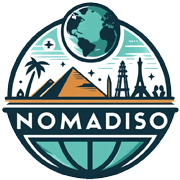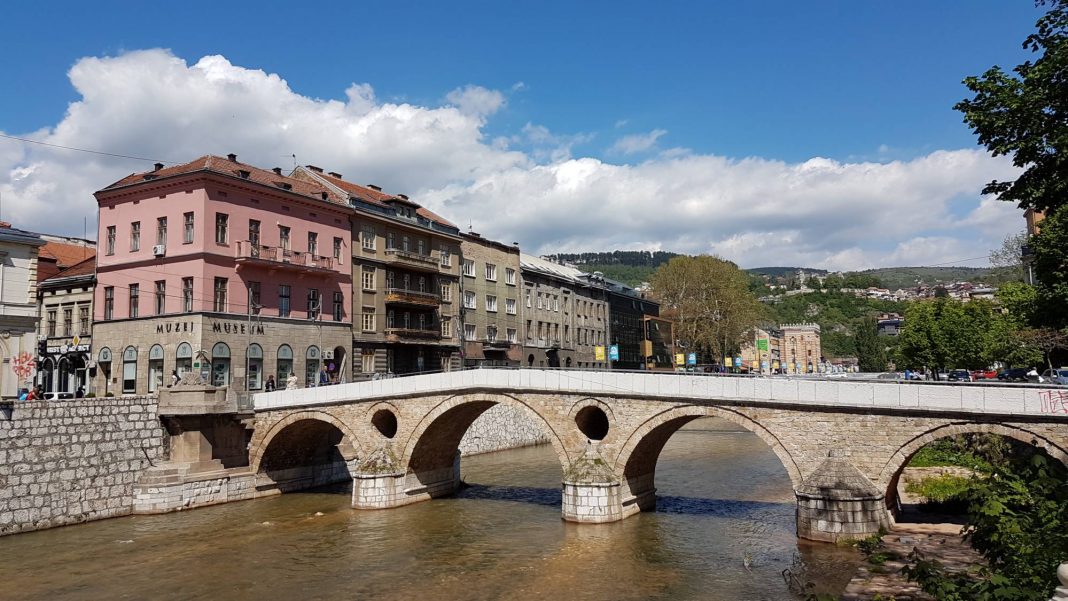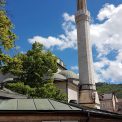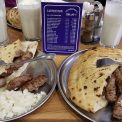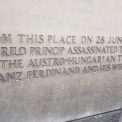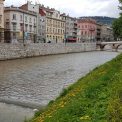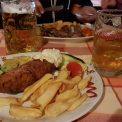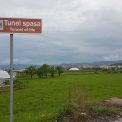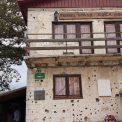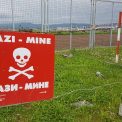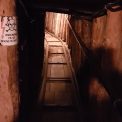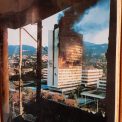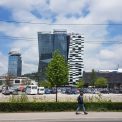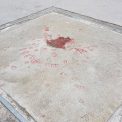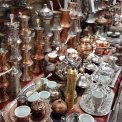Sarajevo is waking up. With a sign like this, you can meet in the capital of Bosnia and Herzegovina – Sarajevo. The city, which was the site of the assassination of Franz Ferdinand, the host of the 1984 Winter Olympics, but also a sad witness of a bloody siege just under ten years later, has been through it all. Sarajevo, with a symbiosis of three religions, is now called the European Jerusalem. Bosnians make up the Muslim part, Serbs the Orthodox, and Croats represent the Catholic part of the population. Similarly, the state is led by three presidents.

Contents
Day 1 – Baščaršija and free city guide
Day 2 – Bobsled Track and fortress ruins
Day 3 – Sarajevo Tunnel
Day 1 – Baščaršija and free city guide
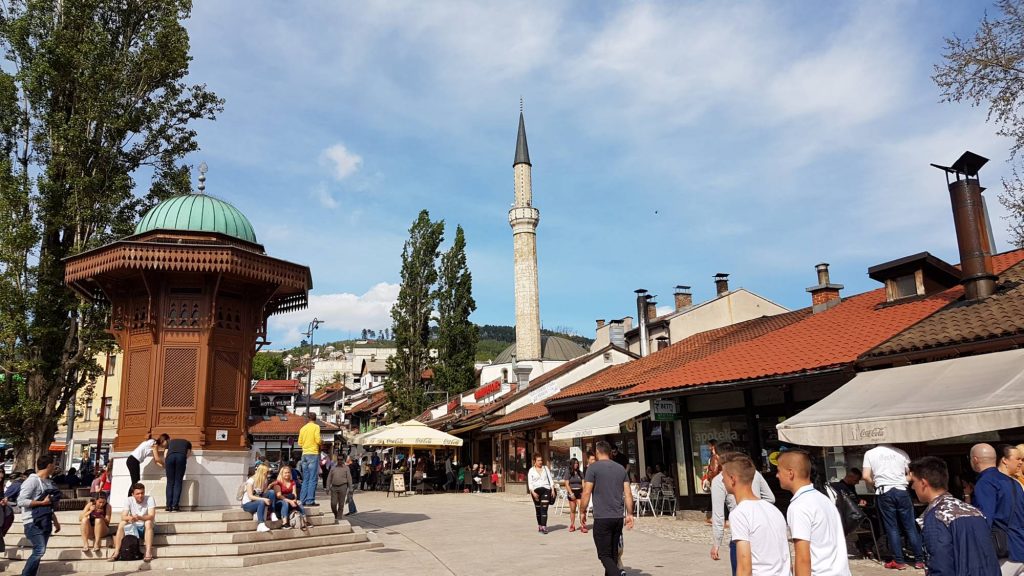
The new Wizzair route Budapest – Sarajevo has been in operation since April 2017. Tickets for a long weekend, from Friday to Monday, can be purchased in advance for an incredible €20. You don’t even need a passport, as we can confirm that an ID card was sufficient.
The flight from Budapest takes about an hour, and around 11:10 we land at the international airport in Sarajevo. The airport is really small and free wifi cannot be found here.
The Convertible Mark (KM) has a fixed exchange rate of 1KM = €0.51, so ATMs and exchange offices should have the same rate everywhere. We tried to withdraw 500KM from an ATM, but the transaction was unsuccessful. The most we managed to withdraw in one transaction was 300KM. As you exit the airport, taxi drivers will approach you, but don’t be swayed, we recommend taking the trolleybus.
TIP: The most economical transport from the airport to the city center is trolleybus no. 103, just exit the airport and walk about 10 minutes to the nearest stopA one-way ticket costs 1.60KM and can be purchased at the kiosk opposite the stop or directly from the driver for 1.80KM. As a bonus, you get a more environmentally friendly mode of transportation, the authenticity of the local trolleybuses, and a city tour as the route goes through the city center along the Miljacka River.
We ride to the final stop Trg Austria, from where you can access the city via the most famous Latin Bridge. It is at the corner of these streets where the assassination of the Austro-Hungarian Duke Franz Ferdinand took place. Today, a museum stands at this location. One of Sarajevo’s European firsts was the introduction of an electric tram network in 1885. Initially, the trams were horse-drawn, and in 1895, electric trams began operating. Only after it proved successful in Sarajevo did electric trams come to Vienna. 🙂
Originally, we booked the Hostel City Center Sarajevo, but upon arrival, we were accommodated in an even better option, the Hostel Vagabond. We are staying right in the heart of the city on Ferhadija Street. To welcome ourselves, we are going to try the traditional national dish cevapi in lepinja bread with yogurt. Following TripAdvisor reviews, we chose the Željo restaurant.
The menu offers options of 5 pieces, 10 pieces, and 15 pieces, referring to the number of cevapi in the bread loaf 🙂 By the end of the trip, you will have had enough of the oily cevapi, but it’s a must-try. This makes the local beer and coffee taste even better. By the way, authentic Bosnian coffee is brewed in a metal pot called a džezva and served in a small cup known as a fildžan. For a quality historical insight into the city, we recommend a free guided city tour.
TIP: The free city guide tour starts at 4:30 PM opposite the museum by the Latin Bridge.
During the tour, we learn more details about the assassination of Franz Ferdinand. The guide talks about the 7 assassins from the organization Young Bosnia. The first two missed their chance, the third threw a grenade but only injured civilians.
After biting a cyanide capsule, Gavrilo Princip jumped off the bridge but unsuccessfully, as the water was only a few centimeters deep, and the capsule was weak. Franz Ferdinand quickly headed to the town hall and on the way back, he wanted to visit the wounded in the hospital.His chauffeur mistakenly turned right at Latin Bridge into an alley where Gavrilo Princip was having coffee. He cold-bloodedly shot him and his wife without hesitation. As Gavrilo was only 19 at that time, he was sentenced to the maximum penalty of 20 years.
From the explanation, we learn that 80% of the population is Muslim, which is why there are so many mosques here. The first one was the Emperor’s Mosque from the 15th century. A great landmark of the city is the City Hall Vijećnica, which serves as the national library.
During the Siege of Sarajevo, a huge number of books were destroyed. Evidence of how residents helped each other in the past is the story of the valuable Jewish book Haggadah, which was hidden during World War II in a Muslim mosque. The tour continues through the streets of the historic Baščaršija quarter. In translation, baš means “main” and čaršija means “bazaar,” and due to the influence of different religions, you will feel like you are in a small Jerusalem here.
One of the city’s symbols is the wooden fountain Sebilj, found on most magnets or bags. The usual price for a magnet is 2KM = approx. 1€. The main artery of the city, Ferhadija Street, starts from the Sebilj fountain and ends at the Eternal Flame Vječna Vatra. On this street lies the most significant mosque from the 16th century, Gazi Husrev-beg Mosque.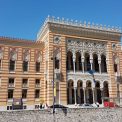
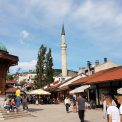
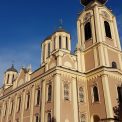
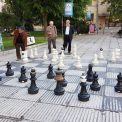
Further down on the floor, you can notice a sign Sarajevo Meeting of Cultures, symbolically dividing western and eastern culture. The free city guide ends with two major churches – the Christian Cathedral of the Sacred Heart of Jesus and the Orthodox Church of the Nativity of the Blessed Virgin. Our guide deserves applause and a tip for the rich explanation. Tonight, TripAdvisor took us to a cozy little “living room” called Cakum Pakum. Excellent savory pancakes filled with meat can only be recommended.
Day 2 – Bobsled Track and fortress Ruins
Today in the afternoon, we plan to visit the bobsleigh track from the 1984 Winter Olympics, or what’s left of it. It was the very first Winter Olympics in a socialist country.
TIP: From Latin Bridge, bus number 98 departs twice a day at 9:00 and 16:00
During the journey, we pass by a sign saying “Serbian Republic,” but it only represents territorial division, not an actual border. We followed Google Maps all the way to the final stop, but the track actually starts at the second to last stop. The bus turned back around noon, which didn’t align with the schedule, so it’s better to ask the driver.
The hiking circuit is approximately 5km long and took us 2 hours with breaks. Today’s bobsleigh track is marked by time, with graffiti-covered concrete. You can let your imagination wander here, picturing how it might have looked during the Winter Olympics. You can climb up the concrete to the starting point of the track, but it wasn’t in any better condition.
The fact that we didn’t encounter anyone further confirms that this tourist attraction has been forgotten. Our journey continues with views of the city and the highest point, Vidikovac, at 1200m above sea level. Along the way, there are signs warning about mines, so venturing into the woods is not the best idea.
We meet the chauffeur at the terminal in the inn, assuring us he wouldn’t leave without us. And since we still have time, a cold beer and a coffee wouldn’t hurt. We get off at the Latin Bridge, from where we continue to the Sarajevo Brewery.
You can’t visit the brewery itself, but you can visit the adjacent pub where you can taste local products and liters of draft beer. Be careful with the menu as the steaks are often just poorly translated stuffed schnitzels (Bosnian Stuffed Schnitzel). It happened to me twice 🙂
For the afternoon, we planned a tour of the remains of two fortresses. The Yellow Fortress now serves as a park with a view of the city. You can reach it by a gentle climb from the town hall past the cemetery. The views of the historic center and the Miljacka River are worth the sweat drops.
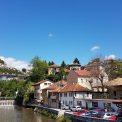

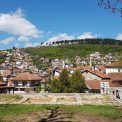
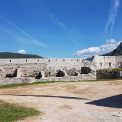
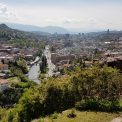 Continuing through narrow alleyways, we ascend to the second fortress called White Fortress. This national monument of Bosnia and Herzegovina was historically known as the old town of Vratnik and dominates the eastern entrance to Sarajevo. After taking photos, we walk back through the streets to Baščaršija. You won’t even realize how time flies by and suddenly it’s evening. Tonight’s winner is the restaurant Dveri, which was one of our top gastronomic experiences.
Continuing through narrow alleyways, we ascend to the second fortress called White Fortress. This national monument of Bosnia and Herzegovina was historically known as the old town of Vratnik and dominates the eastern entrance to Sarajevo. After taking photos, we walk back through the streets to Baščaršija. You won’t even realize how time flies by and suddenly it’s evening. Tonight’s winner is the restaurant Dveri, which was one of our top gastronomic experiences.
Day 3 – Sarajevo Tunnel
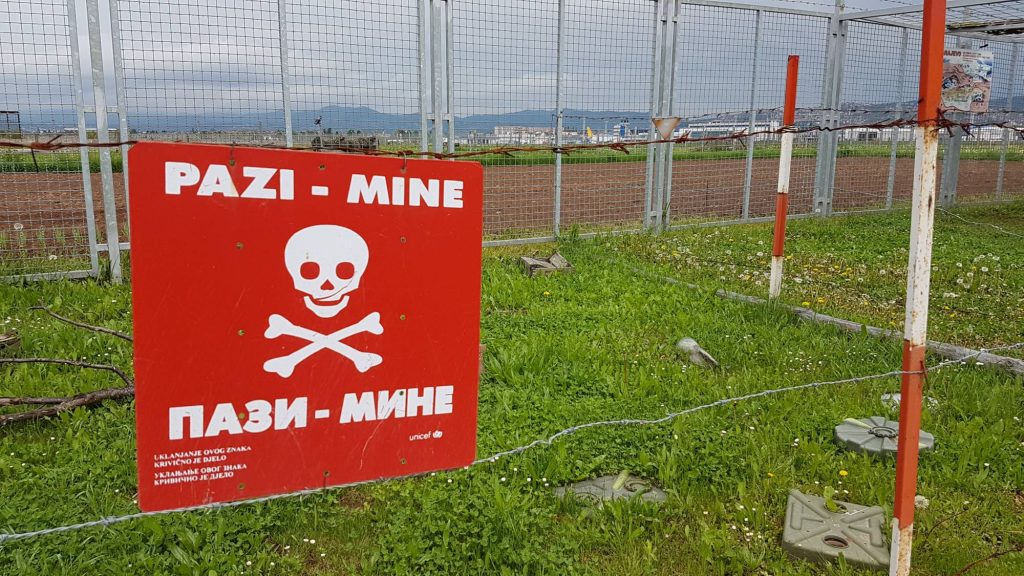
On the last day, we saved the most interesting for last – Sarajevo Tunnel or Tunnel of Hope. Located near the airport, if you don’t want to deal with overpriced taxis, there are two transportation options. Tram 3 + bus 32 or trolleybus 103 + 30 minutes walking. We chose the second option. We get off at the last stop of trolleybus 103 and bypass the airport from the left. The entrance fee to the area is 10KM per person.
At the beginning, you watch a powerful, sad video about the course of the bloody Siege of Sarajevo and the construction of the tunnel. The Tunnel of Hope, built in 4 months and 4 days under the airport runway, was 800 meters long and only 1.6 meters high. Iron tracks were laid there to transport supplies, medicine, wounded, and the dead on carts.
It also served for transporting fuel and communication, as a telephone cable was installed there. From July 1993 until the end of the war in 1995, approximately 3 million people passed through it in both directions.
After the video, there is a free tour of the garden with ammunition and a walk through the tunnel itself. Not the whole tunnel, but only a 20-meter section. The enormous military siege of Sarajevo is detailed with army numbers on boards. Over 300 shells fell on the city daily. These places are still marked with red tears in the city’s pavements. You will need half a day for a tunnel tour.
In the afternoon, we stroll around our historic Baščaršija again. Lunch, coffee, square, churches, and a few souvenirs. As a sweet souvenir, we can recommend chocolate cakes filled with plum, nuts, honey, and cinnamon. You can find them at a place called Mak Zara Natural Mix. If you like skyscrapers as much as I do, it’s also worth visiting the Avaz Twist Tower (172m), which is the tallest building in the former Yugoslavia territory. The entrance to the viewpoint is only 1KM.
